brake light Lexus ES350 2020 Owner's Manuals / LEXUS 2020 ES350 THROUGH SEPT. 2019 PROD. OWNER'S MANUAL (OM06174U)
[x] Cancel search | Manufacturer: LEXUS, Model Year: 2020, Model line: ES350, Model: Lexus ES350 2020Pages: 448, PDF Size: 9.77 MB
Page 3 of 448
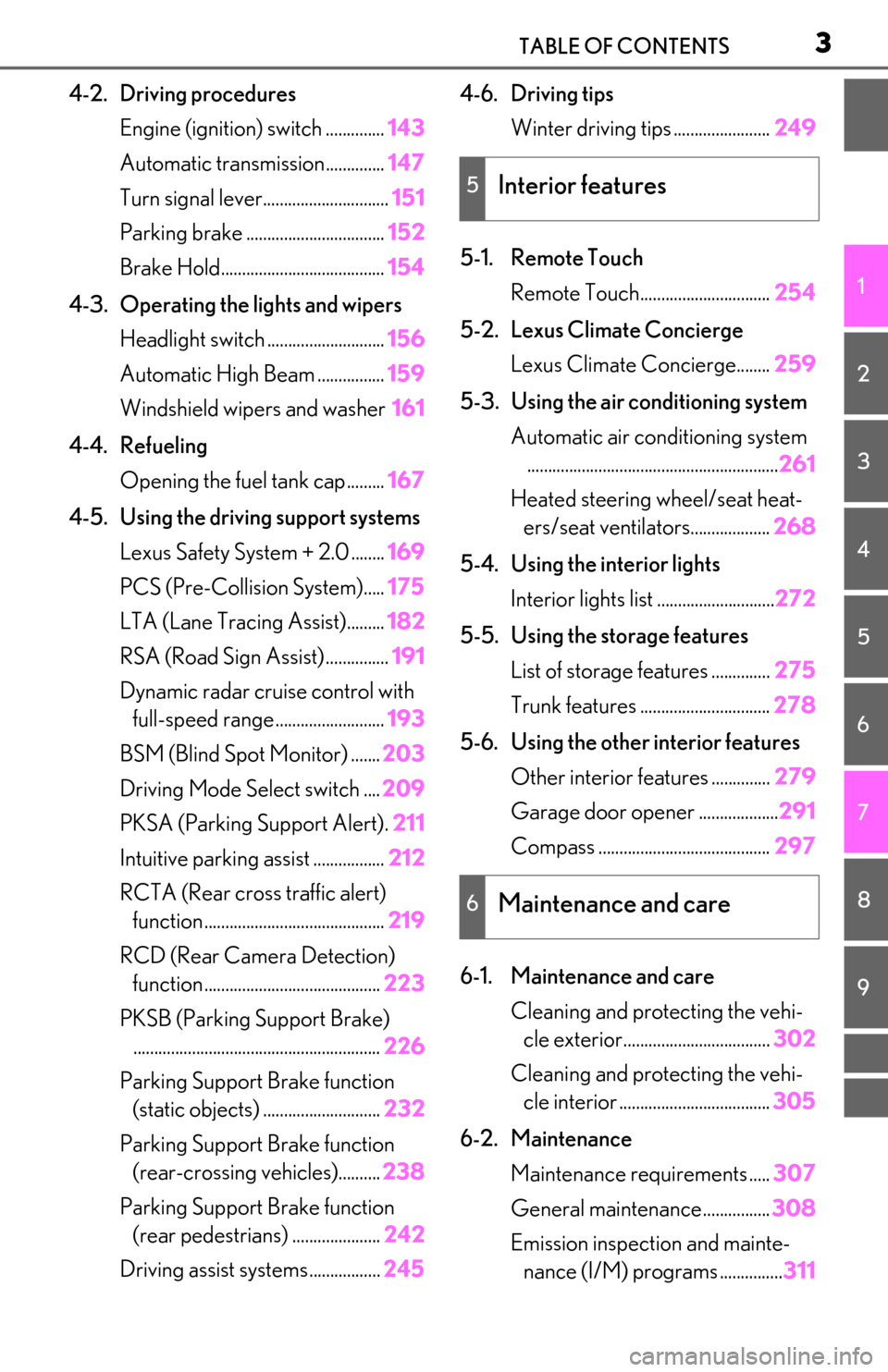
3TABLE OF CONTENTS
1
2
3
4
5
6
7
8
9
4-2. Driving proceduresEngine (ignition) switch .............. 143
Automatic transmission.............. 147
Turn signal lever.............................. 151
Parking brake ................................. 152
Brake Hold....................................... 154
4-3. Operating the lights and wipers Headlight switch ............................ 156
Automatic High Beam ................ 159
Windshield wipers and washer 161
4-4. Refueling Opening the fuel tank cap......... 167
4-5. Using the driving support systems Lexus Safety System + 2.0 ........ 169
PCS (Pre-Collision System)..... 175
LTA (Lane Tracing Assist)......... 182
RSA (Road Sign Assist) ............... 191
Dynamic radar crui se control with
full-speed range.......................... 193
BSM (Blind Spot Monitor) ....... 203
Driving Mode Select switch .... 209
PKSA (Parking Support Alert). 211
Intuitive parking assist ................. 212
RCTA (Rear cross traffic alert) function ........................................... 219
RCD (Rear Camera Detection) function .......................................... 223
PKSB (Parking Support Brake) ........................................................... 226
Parking Support Brake function (static objects) ............................ 232
Parking Support Brake function (rear-crossing vehicles).......... 238
Parking Support Brake function (rear pedestrians) ..................... 242
Driving assist systems ................. 2454-6. Driving tips
Winter driving tips ....................... 249
5-1. Remote Touch Remote Touch............................... 254
5-2. Lexus Climate Concierge Lexus Climate Concierge........ 259
5-3. Using the air conditioning system Automatic air conditioning system............................................................ 261
Heated steering wheel/seat heat- ers/seat ventilators................... 268
5-4. Using the interior lights Interior lights list ............................ 272
5-5. Using the storage features List of storage features .............. 275
Trunk features ............................... 278
5-6. Using the other interior features Other interior features .............. 279
Garage door opener ................... 291
Compass ......................................... 297
6-1. Maintenance and care Cleaning and protecting the vehi-cle exterior................................... 302
Cleaning and protecting the vehi- cle interior .................................... 305
6-2. Maintenance Maintenance re quirements
.....307
General maintenance................ 308
Emission inspection and mainte- nance (I/M) programs ............... 311
5Interior features
6Maintenance and care
Page 15 of 448

15Pictorial index
Parking brake switch ............................................................................................. P.152
Applying/releasing ........................................................................................................... P.152
Precautions against winter season ................... .........................................................P.250
Warning buzzer/message............................................................................................ P.365
Turn signal lever ....................................................................................................... P.151
Headlight switch...................................................................................................... P.156
Headlights/parking lights/tail lights/daytime running lights ........................... P.156
Automatic High Beam ..................................................................................................... P.159
Windshield wiper and washer switch ................................................................. P.161
Usage........................................................................................................................................ P.161
Adding washer fluid ...........................................................................................................P .321
Warning messages .......................................................................................................... P.365
Emergency flasher switch ...................................................................................P.346
Hood lock release lever ........................................................................................ P.314
Tilt and telescopic steering control swit ch/tilt and telescopic steering lock
release lever .............................................................................................................. P.11 9
Adjustment ..................................................................................................................... ........ P.119
Driving position memory
*1............................................................................................... P.114
Air conditioning system ........................................................................................ P.261
Usage.......................................................................................................................... .............P.261
Rear window defogger................................................................................................... P.262
Audio system
*2
Trunk opener main switch ....................................................................................P.105
*1: If equipped
*2: Refer to “NAVIGATION AND MULTIMEDIA SYSTEM OWNER’S MANUAL”.
E
F
G
H
I
J
K
L
M
Page 67 of 448
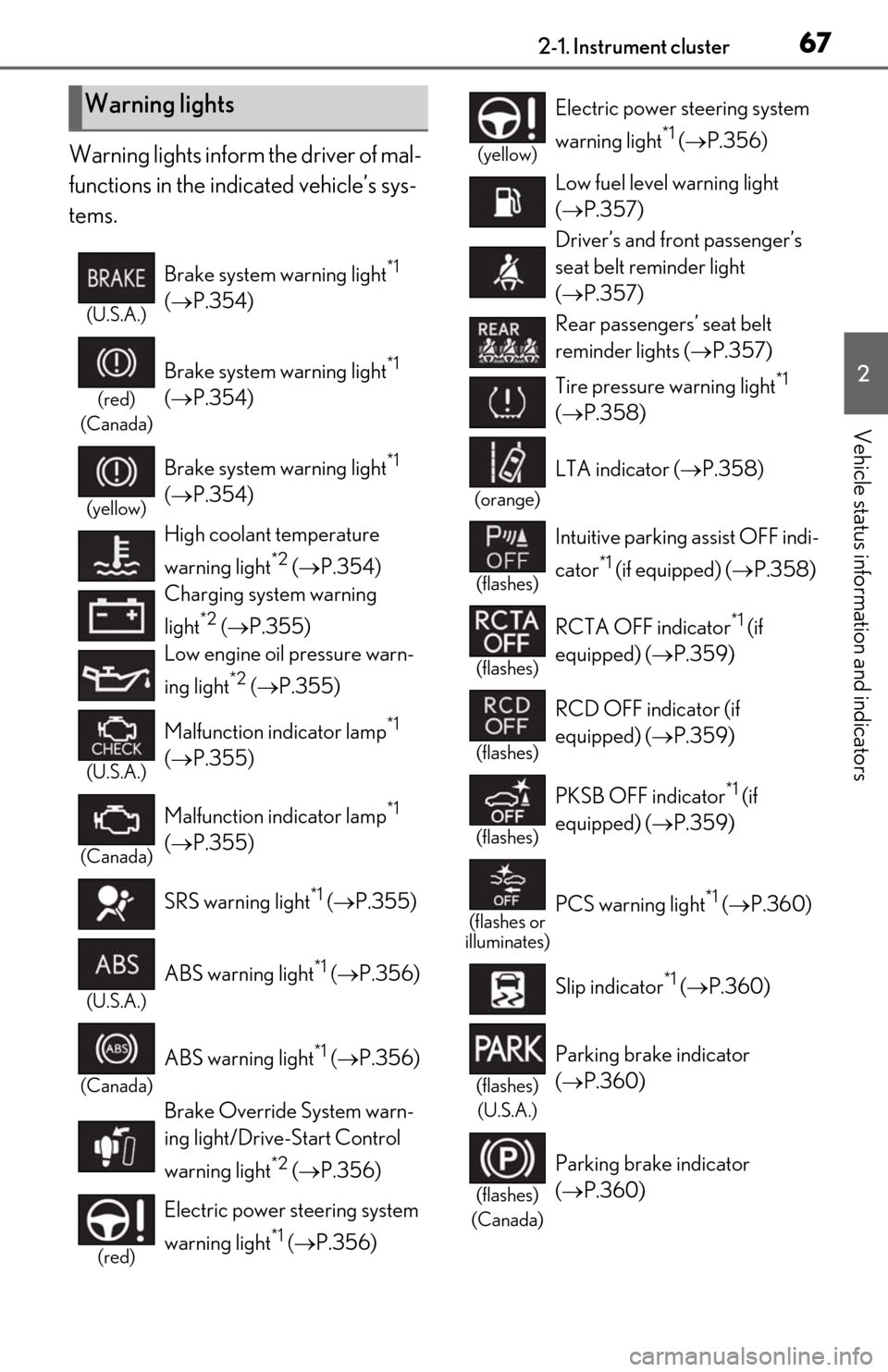
672-1. Instrument cluster
2
Vehicle status information and indicators
Warning lights inform the driver of mal-
functions in the indicated vehicle’s sys-
tems.
Warning lights
(U.S.A.)
Brake system warning light*1
( P.354)
(red)
(Canada)
Brake system warning light*1
( P.354)
(yellow)
Brake system warning light*1
( P.354)
High coolant temperature
warning light
*2 ( P.354)
Charging system warning
light
*2 ( P.355)
Low engine oil pressure warn-
ing light
*2 ( P.355)
(U.S.A.)
Malfunction indicator lamp*1
( P.355)
(Canada)
Malfunction indicator lamp*1
( P.355)
SRS warning light
*1 ( P.355)
(U.S.A.)
ABS warning light*1 ( P.356)
(Canada)
ABS warning light*1 ( P.356)
Brake Override System warn-
ing light/Drive-Start Control
warning light
*2 ( P.356)
(red)
Electric power st eering system
warning light
*1 ( P.356)
(yellow)
Electric power steering system
warning light
*1 ( P.356)
Low fuel level warning light
( P.357)
Driver’s and front passenger’s
seat belt re minder light
( P.357)
Rear passengers’ seat belt
reminder lights ( P.357)
Tire pressure warning light
*1
( P.358)
(orange)
LTA indicator ( P.358)
(flashes)
Intuitive parking assist OFF indi-
cator
*1 (if equipped) (P.358)
(flashes)
RCTA OFF indicator*1 (if
equipped) ( P.359)
(flashes)
RCD OFF indicator (if
equipped) (P.359)
(flashes)
PKSB OFF indicator*1 (if
equipped) ( P.359)
(flashes or
illuminates)PCS warning light*1 ( P.360)
Slip indicator
*1 ( P.360)
(flashes)
(U.S.A.)
Parking brake indicator
( P.360)
(flashes)
(Canada)
Parking brake indicator
( P.360)
Page 68 of 448

682-1. Instrument cluster
*1: These lights come on when the engine switch is turned to IGNITION ON
mode to indicate that a system check is
being performed. They will go off after
the engine is on, or after a few seconds.
There may be a malfunction in a system
if the lights do not come on, or go off.
Have the vehicle inspected by your
Lexus dealer.
*2: This light illuminates on the multi-infor- mation display.
The indicators inform the driver of the
operating state of the vehicle’s various
systems.
(flashes)
Brake hold operated indicator*1
( P.361)
Master warning light
*1
( P.361)
WARNING
■If a safety system warning light does
not come on
Should a safety system light such as the
ABS and SRS warning light not come on
when you start the engine, this could
mean that these systems are not available
to help protect you in an accident, which
could result in death or serious injury.
Have the vehicle inspected by your
Lexus dealer immediately if this occurs.
Indicators
Turn signal indicator ( P.151)
(U.S.A.)
Headlight indicator ( P.156)
(Canada)
Tail light indicator ( P.156)
Headlight high beam indicator
( P.158)
Automatic High Beam indicator
( P.159)
PCS warning light
*1, 2 ( P.175)
Cruise control indicator
( P.193)
Dynamic radar cruise control
indicator ( P.193)
Cruise control “SET” indicator
( P.193)
(white)
LTA indicator ( P.187)
(green)
LTA indicator (P.187)
(orange)
(flashes)LTA indicator ( P.187)
BSM outside rear view mirror
indicators
*1, 3 (if equipped)
( P.203, 219)
BSM indicator (if equipped)
( P.203)
Intuitive parking assist OFF indi-
cator
*1, 2 (if equipped)
( P.213)
RCTA OFF indicator
*1, 2 (if
equipped) ( P.219)
RCD OFF indicator
*2 (if
equipped) ( P.223)
PKSB OFF indicator
*1, 2 (if
equipped) ( P.227)
(flashes)
Slip indicator*1 ( P.246)
VSC OFF indicator
*1, 2
( P.246)
Page 69 of 448
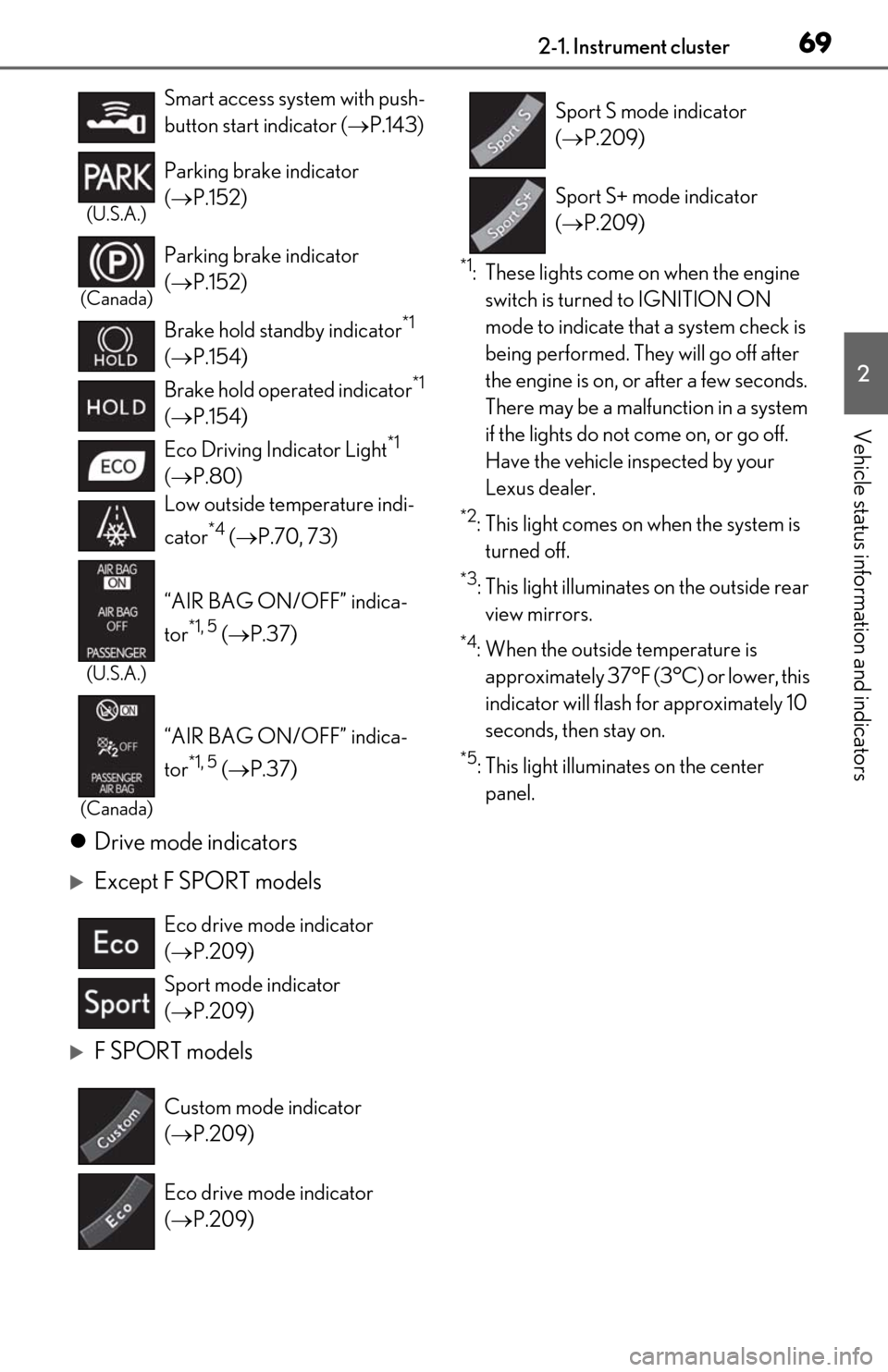
692-1. Instrument cluster
2
Vehicle status information and indicators
Drive mode indicators
Except F SPORT models
F SPORT models
*1: These lights come on when the engine
switch is turned to IGNITION ON
mode to indicate that a system check is
being performed. They will go off after
the engine is on, or after a few seconds.
There may be a malfunction in a system
if the lights do not come on, or go off.
Have the vehicle inspected by your
Lexus dealer.
*2: This light comes on when the system is turned off.
*3: This light illuminates on the outside rear view mirrors.
*4: When the outside temperature is approximately 37°F (3°C) or lower, this
indicator will flash for approximately 10
seconds, then stay on.
*5: This light illuminates on the center panel.
Smart access system with push-
button start indicator (
P.143)
(U.S.A.)
Parking brake indicator
( P.152)
(Canada)
Parking brake indicator
( P.152)
Brake hold standby indicator
*1
( P.154)
Brake hold operated indicator
*1
( P.154)
Eco Driving Indicator Light
*1
( P.80)
Low outside temperature indi-
cator
*4 ( P.70, 73)
(U.S.A.)
“AIR BAG ON/OFF” indica-
tor
*1, 5 ( P.37)
(Canada)
“AIR BAG ON/OFF” indica-
tor
*1, 5 ( P.37)
Eco drive mode indicator
( P.209)
Sport mode indicator
( P.209)
Custom mode indicator
( P.209)
Eco drive mode indicator
( P.209)
Sport S mode indicator
( P.209)
Sport S+ mode indicator
( P.209)
Page 133 of 448
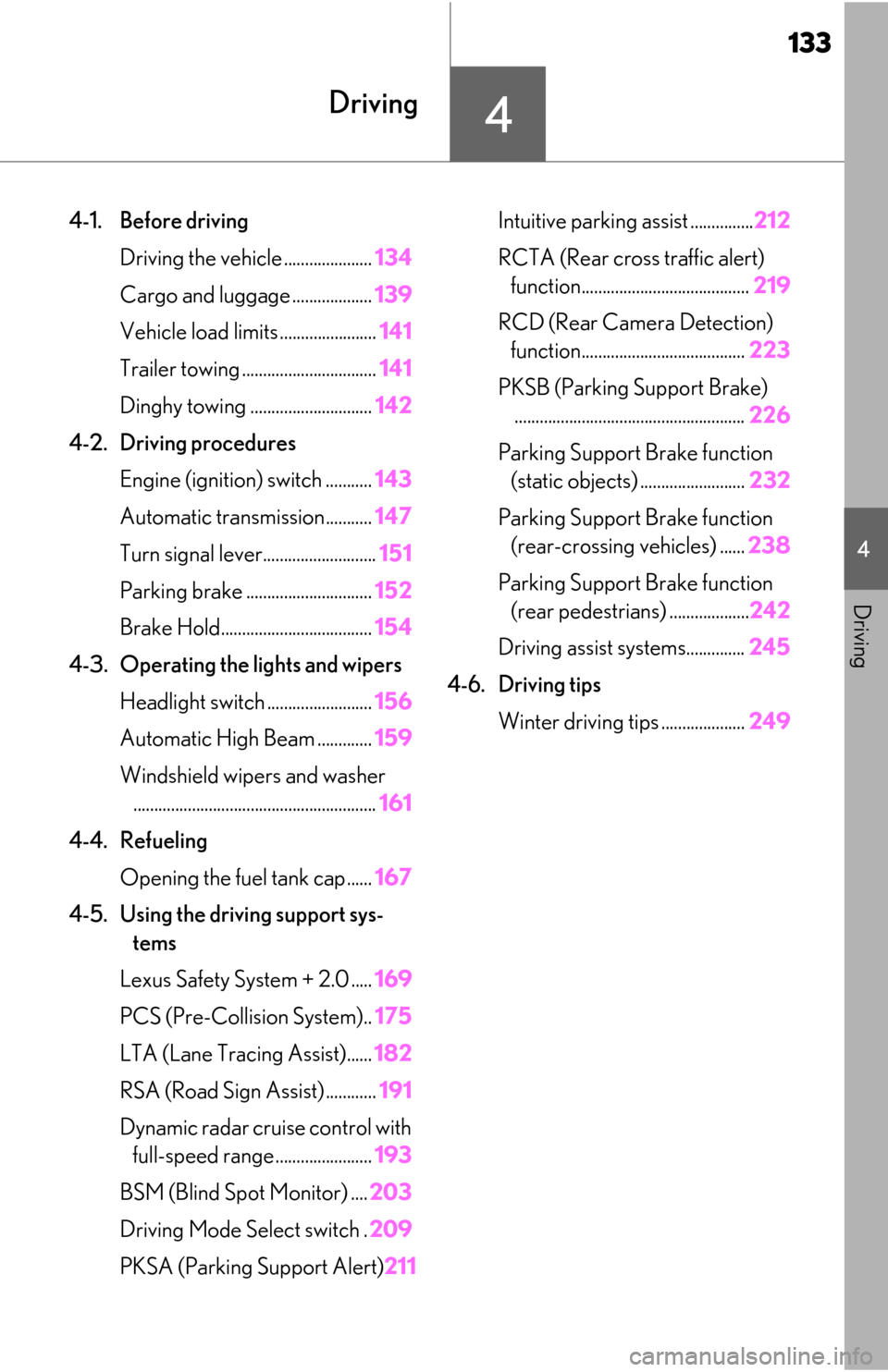
133
4
4
Driving
Driving
4-1. Before drivingDriving the vehicle ..................... 134
Cargo and luggage ................... 139
Vehicle load limits ....................... 141
Trailer towing ................................ 141
Dinghy towing ............................. 142
4-2. Driving procedures Engine (ignition) switch ........... 143
Automatic transmission........... 147
Turn signal lever........................... 151
Parking brake .............................. 152
Brake Hold.................................... 154
4-3. Operating the lights and wipers Headlight switch ......................... 156
Automatic High Beam ............. 159
Windshield wipers and washer .......................................................... 161
4-4. Refueling Opening the fuel tank cap...... 167
4-5. Using the driving support sys- tems
Lexus Safety System + 2.0 ..... 169
PCS (Pre-Collision System).. 175
LTA (Lane Tracing Assist)...... 182
RSA (Road Sign Assist) ............ 191
Dynamic radar cruise control with full-speed range....................... 193
BSM (Blind Spot Monitor) .... 203
Driving Mode Select switch . 209
PKSA (Parking Support Alert) 211Intuitive parking assist ...............
212
RCTA (Rear cross traffic alert) function........................................ 219
RCD (Rear Camera Detection) function....................................... 223
PKSB (Parking Support Brake) ....................................................... 226
Parking Support Brake function (static objects) ......................... 232
Parking Support Brake function (rear-crossing vehicles) ...... 238
Parking Support Brake function (rear pedestrians) ................... 242
Driving assist systems.............. 245
4-6. Driving tips Winter driving tips .................... 249
Page 135 of 448
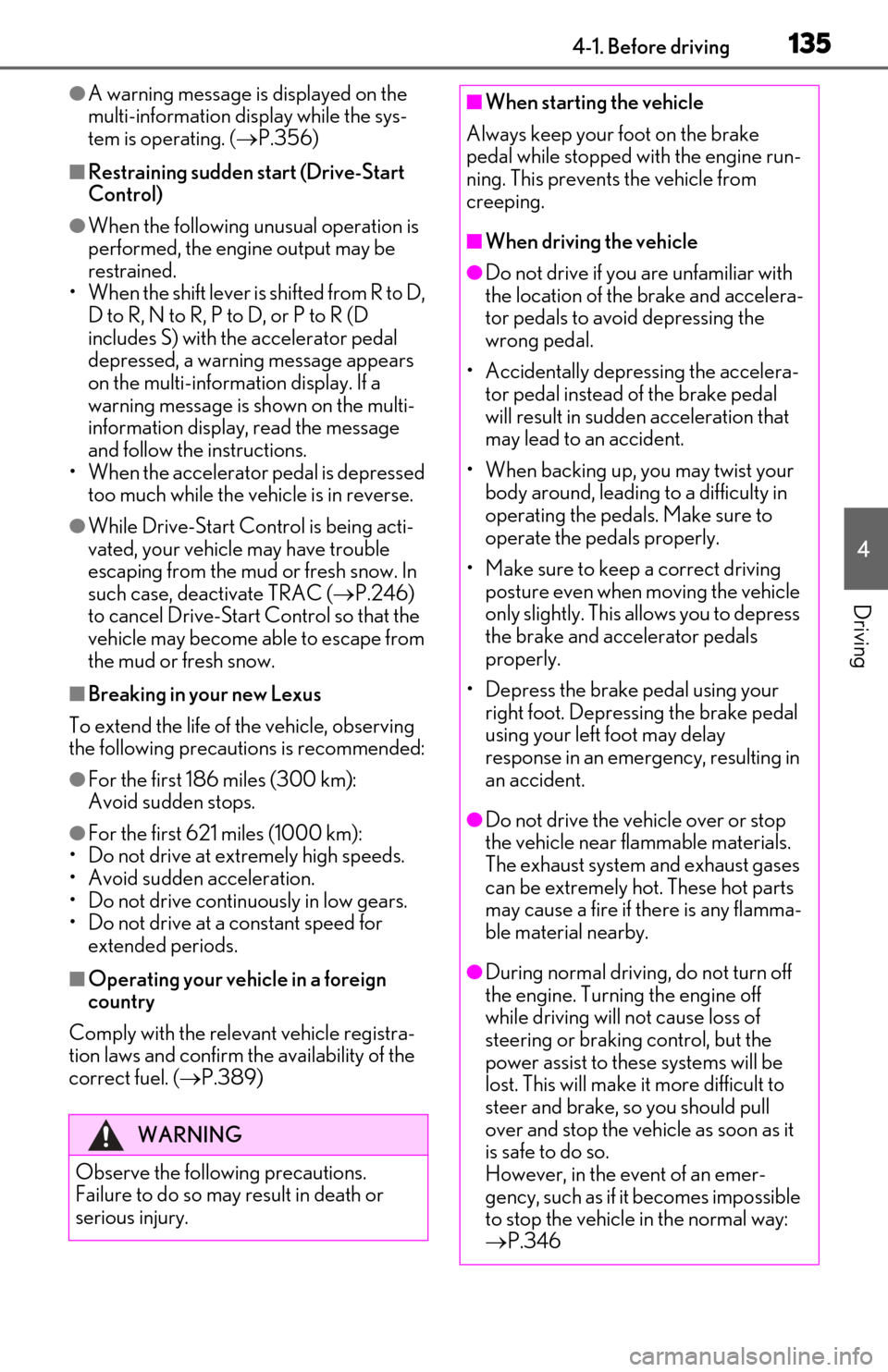
1354-1. Before driving
4
Driving
●A warning message is displayed on the
multi-information display while the sys-
tem is operating. ( P.356)
■Restraining sudden start (Drive-Start
Control)
●When the following unusual operation is
performed, the engine output may be
restrained.
• When the shift lever is shifted from R to D, D to R, N to R, P to D, or P to R (D
includes S) with the accelerator pedal
depressed, a warning message appears
on the multi-information display. If a
warning message is shown on the multi-
information display, read the message
and follow the instructions.
• When the accelerator pedal is depressed
too much while the vehicle is in reverse.
●While Drive-Start Control is being acti-
vated, your vehicle may have trouble
escaping from the mud or fresh snow. In
such case, deactivate TRAC ( P.246)
to cancel Drive-Start Control so that the
vehicle may become able to escape from
the mud or fresh snow.
■Breaking in your new Lexus
To extend the life of the vehicle, observing
the following precautions is recommended:
●For the first 186 miles (300 km):
Avoid sudden stops.
●For the first 621 miles (1000 km):
• Do not drive at extremely high speeds.
• Avoid sudden acceleration.
• Do not drive continuously in low gears.
• Do not drive at a constant speed for
extended periods.
■Operating your vehicle in a foreign
country
Comply with the relevant vehicle registra-
tion laws and confirm the availability of the
correct fuel. ( P.389)
WARNING
Observe the following precautions.
Failure to do so may result in death or
serious injury.
■When starting the vehicle
Always keep your foot on the brake
pedal while stopped with the engine run-
ning. This prevents the vehicle from
creeping.
■When driving the vehicle
●Do not drive if you are unfamiliar with
the location of the brake and accelera-
tor pedals to avoid depressing the
wrong pedal.
• Accidentally depressing the accelera- tor pedal instead of the brake pedal
will result in sudden acceleration that
may lead to an accident.
• When backing up, you may twist your body around, leading to a difficulty in
operating the pedals. Make sure to
operate the pedals properly.
• Make sure to keep a correct driving posture even when moving the vehicle
only slightly. This allows you to depress
the brake and accelerator pedals
properly.
• Depress the brake pedal using your right foot. Depressing the brake pedal
using your left foot may delay
response in an emergency, resulting in
an accident.
●Do not drive the vehicle over or stop
the vehicle near flammable materials.
The exhaust system and exhaust gases
can be extremely hot. These hot parts
may cause a fire if there is any flamma-
ble material nearby.
●During normal driving, do not turn off
the engine. Turning the engine off
while driving will not cause loss of
steering or braking control, but the
power assist to these systems will be
lost. This will make it more difficult to
steer and brake, so you should pull
over and stop the vehicle as soon as it
is safe to do so.
However, in the event of an emer-
gency, such as if it becomes impossible
to stop the vehicle in the normal way:
P.346
Page 136 of 448

1364-1. Before driving
WARNING
●Use engine braking (downshift) to
maintain a safe speed when driving
down a steep hill.
Using the brakes continuously may
cause the brakes to overheat and lose
effectiveness. (P.147)
●Do not adjust the positions of the
steering wheel, the seat, or the inside
or outside rear view mirrors while driv-
ing.
Doing so may result in a loss of vehicle
control.
●Always check that all passengers’
arms, heads or other parts of their
body are not outside the vehicle.
●Do not drive in excess of the speed
limit. Even if the legal speed limit per-
mits it, do not drive over 85 mph (140
km/h) unless your vehicle has high-
speed capability tires. Driving over 85
mph (140 km/h) may result in tire fail-
ure, loss of control and possible injury.
Be sure to consult a tire dealer to
determine whether the tires on your
vehicle are high-speed capability tires
or not before driving at such speeds.
■When driving on slippery road sur-
faces
●Sudden braking, acceleration and
steering may cause tire slippage and
reduce your ability to control the vehi-
cle.
●Sudden acceleration, engine braking
due to shifting, or changes in engine
speed could cause the vehicle to skid,
resulting in an accident.
●After driving through a puddle, lightly
depress the brake pedal to make sure
that the brakes are functioning prop-
erly. Wet brake pads may prevent the
brakes from functioning properly. If the
brakes on only one side are wet and
not functioning properly, steering con-
trol may be affected.
■When shifting the shift lever
●Do not let the vehicle roll backward
while the shift lever is in a driving posi-
tion or roll forward while the shift lever
is in R.
Doing so may cause the engine to stall
or lead to poor brake and steering
performance, resulting in an accident
or damage to the vehicle.
●Do not shift the shif t lever to P while
the vehicle is moving.
Doing so can damage the transmission
and may result in a loss of vehicle con-
trol.
●Do not shift the shift lever to R while
the vehicle is moving forward.
Doing so can damage the transmission
and may result in a loss of vehicle con-
trol.
●Do not shift the shift lever to a driving
position while the vehicle is moving
backward.
Doing so can damage the transmission
and may result in a loss of vehicle con-
trol.
●Shifting the shift lever to N while the
vehicle is moving will disengage the
engine from the transmission. Engine
braking is not available when N is
selected.
●Be careful not to shift the shift lever
with the accelerator pedal depressed.
Shifting the shift lever to a gear other
than P or N may lead to unexpected
rapid acceleration of the vehicle that
may cause an accident and result in
death or serious injury.
■If you hear a squealing or scraping
noise (brake pad wear limit indica-
tors)
Have the brake pads checked and
replaced by your Lexus dealer as soon as
possible. Rotor damage may result if the
pads are not replaced when needed. It is
dangerous to drive the vehicle when the
wear limits of the brake pads and/or
those of the brake discs are exceeded.
Page 137 of 448

1374-1. Before driving
4
Driving
WARNING
■When the vehicle is stopped
●Do not race the engine.
If the vehicle is in any gear other than P
or N, the vehicle may accelerate sud-
denly and unexpectedly, causing an
accident.
●In order to prevent accidents due to
the vehicle rolling away, always keep
depressing the brake pedal while the
engine is running, and apply the park-
ing brake as necessary.
●If the vehicle is stopped on an incline,
in order to prevent accidents caused
by the vehicle rolling forward or back-
ward, always depress the brake pedal
and securely apply the parking brake
as needed.
●Avoid revving or racing the engine.
Running the engine at high speed
while the vehicle is stopped may cause
the exhaust system to overheat, which
could result in a fire if combustible
material is nearby.
■When the vehicle is parked
●Do not leave glasses, cigarette lighters,
spray cans, or soft drink cans in the
vehicle when it is in the sun.
Doing so may result in the following:
• Gas may leak from a cigarette lighter or spray can, and may lead to a fire.
• The temperature inside the vehicle may cause the plastic lenses and plas-
tic material of glasses to deform or
crack.
• Soft drink cans may fracture, causing the contents to spray over the interior
of the vehicle, and may also cause a
short circuit in the vehicle’s electrical
components.
●Do not leave cigarette lighters in the
vehicle. If a cigarette lighter is in a
place such as the glove box or on the
floor, it may be lit accidentally when
luggage is loaded or the seat is
adjusted, causing a fire.
●Do not attach adhesive discs to the
windshield or windows. Do not place
containers such as air fresheners on
the instrument panel or dashboard.
Adhesive discs or containers may act
as lenses, causing a fire in the vehicle.
●Do not leave a door or window open if
the curved glass is coated with a met-
allized film such as a silver-colored
one. Reflected sunlight may cause the
glass to act as a lens, causing a fire.
●Always apply the parking brake, shift
the shift lever to P, stop the engine and
lock the vehicle.
Do not leave the vehicle unattended
while the engine is running.
If the vehicle is parked with the shift
lever in P but the parking brake is not
set, the vehicle may start to move, pos-
sibly leading to an accident.
●Do not touch the exhaust pipes while
the engine is running or immediately
after turning the engine off.
Doing so may cause burns.
■When taking a nap in the vehicle
Always turn the engine off. Otherwise, if
you accidentally move the shift lever or
depress the accelerator pedal, this could
cause an accident or fire due to engine
overheating. Additionally, if the vehicle is
parked in a poorly ventilated area,
exhaust gases may collect and enter the
vehicle, leading to death or a serious
health hazard.
■When braking
●When the brakes are wet, drive more
cautiously.
Braking distance in creases when the
brakes are wet, and this may cause one
side of the vehicle to brake differently
than the other side. Also, the parking
brake may not securely hold the vehi-
cle.
Page 145 of 448
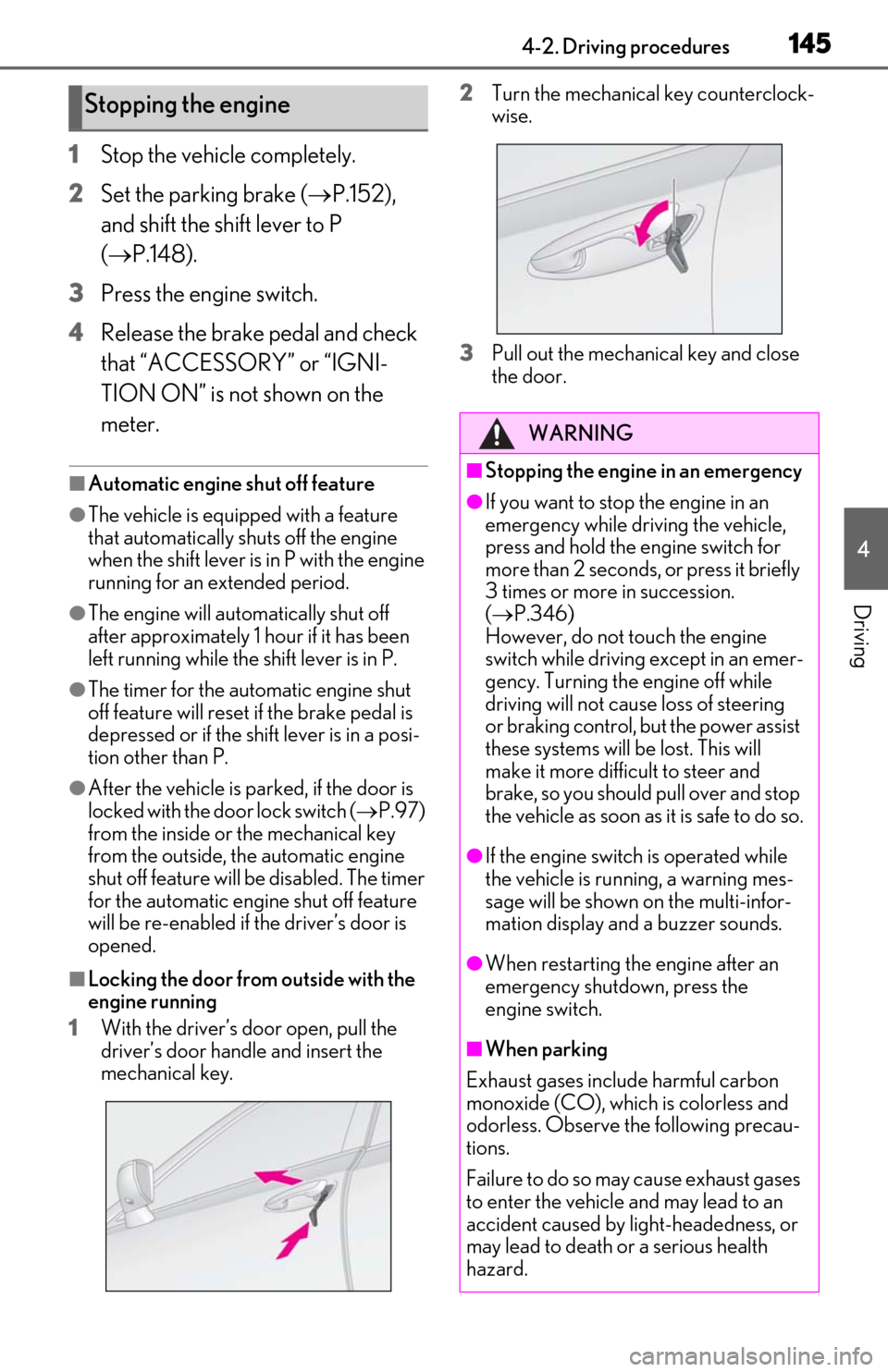
1454-2. Driving procedures
4
Driving
1Stop the vehicle completely.
2
Set the parking brake ( P.152),
and shift the shift lever to P
( P.148).
3
Press the engine switch.
4
Release the brake pedal and check
that “ACCESSORY” or “IGNI-
TION ON” is not shown on the
meter.
■Automatic engine shut off feature
●The vehicle is equipped with a feature
that automatically shuts off the engine
when the shift lever is in P with the engine
running for an extended period.
●The engine will automatically shut off
after approximately 1 hour if it has been
left running while the shift lever is in P.
●The timer for the automatic engine shut
off feature will reset if the brake pedal is
depressed or if the shif t lever is in a posi-
tion other than P.
●After the vehicle is parked, if the door is
locked with the door lock switch ( P.97)
from the inside or the mechanical key
from the outside, the automatic engine
shut off feature will be disabled. The timer
for the automatic engine shut off feature
will be re-enabled if the driver’s door is
opened.
■Locking the door from outside with the
engine running
1
With the driver’s door open, pull the
driver’s door handle and insert the
mechanical key. 2
Turn the mechanical key counterclock-
wise.
3
Pull out the mechanical key and close
the door.
Stopping the engine
WARNING
■Stopping the engine in an emergency
●If you want to stop the engine in an
emergency while driving the vehicle,
press and hold the engine switch for
more than 2 seconds, or press it briefly
3 times or more in succession.
( P.346)
However, do not touch the engine
switch while driving except in an emer-
gency. Turning the engine off while
driving will not cause loss of steering
or braking control, but the power assist
these systems will be lost. This will
make it more difficult to steer and
brake, so you should pull over and stop
the vehicle as soon as it is safe to do so.
●If the engine switch is operated while
the vehicle is running, a warning mes-
sage will be shown on the multi-infor-
mation display and a buzzer sounds.
●When restarting the engine after an
emergency shutdown, press the
engine switch.
■When parking
Exhaust gases include harmful carbon
monoxide (CO), which is colorless and
odorless. Observe the following precau-
tions.
Failure to do so may cause exhaust gases
to enter the vehicle and may lead to an
accident caused by light-headedness, or
may lead to death or a serious health
hazard.